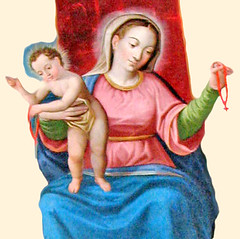O Decor Carmelis!
 NB: This has been posted in advance of the date above.
NB: This has been posted in advance of the date above.In the Philippines, the Brown Scapular of Our Lady of Mount Carmel is seen on almost everyone, especially children. As a sacramental, it is a potent sign of Our Lady's protection, of being cared for by her, just as every child is first clothed by their mother. However, this beautiful sacramental can also be viewed superstitiously as a kind of talisman, which denigrates this gift of Mary to the Carmelite Order and through them, to us. There is certainly a delicate balance between faith in Mary's intercession and the scapular as a sign of her motherly love and protection and a superstitious faith in the scapular itself as an almost magical charm or object or even a ticket to heaven!
The former is precisely what the donning of the scapular (with its attendant responsibilities of prayer and chastity of life) invites us to and in return we are granted the Sabbatine Privilege, that is to say, Our Lady herself will retrieve us from purgatory on the first Saturday after our death if we worthily wear the scapular throughout our lives. I personally feel this does not mean we can never ever take off the scapular (because this makes one prone to superstition) although it is noteworthy that Pope John Paul II reputedly insisted that he wore it even during his operation in 1981 after the assasination attempt on his life. Moreover, the Carmelites have many stories of miraculous rescues from death for those who wore the scapular.
A scapular is in essence a garment worn by medieval labourers to protect their clothes from being soiled. As such, we too may be reminded that when we take on the scapular (much truncated in form) we are to keep our souls free from the stain of sin. It also came to symbolize the gentle yoke of Christ, thus we are reminded in wearing it to learn from him to be gentle and humble of heart.
According to Carmelite tradtions on this day in 1251, the scapular was given to the English Carmelite, St Simon Stock (C.1165 - 1265) by Our Lady in a vision where upon she promised that: "Hoc erit tibi et cunctis Carmelitis privilegium, in hoc habitu moriens salvabitur" (This shall be the privilege for you and for all the Carmelites, that anyone dying in this habit shall be saved). Certainly this was initially understood to mean just the habit of the Carmelites but this was extended to anyone who is now 'enrolled' as an associate of the Order by means of the imposition of the scapular. It is a marked broadening of the original promise but not objectionably so, for God desires salvation for all people.
A final word about Carmel: this is the mountain on which Elijah defeated the prophets of Baal (cf 1 Kings 18). It rises from the plain of Esdraelon about 60 miles northwest of Jerusalem. It's Hebrew name means 'orchard' and the Arabs call it Jabal Mar Elias, the mount of the prophet Elijah. On this great mount of victory, hermits gathered and monastery was founded sometime before 570 aD. In 1156, the Carmelites were formed, due in part by the many Christian pilgrims in the Holy Land. After the fall of Jerusalem, they had to retreat to Christian countries but their roots are still firmly founded on that Holy Mountain, in Christ and Our Lady.







0 Comments:
Post a Comment
<< Home